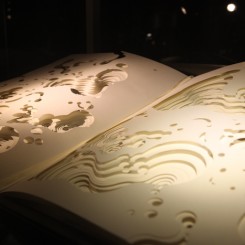Although there is no lack of artist books displaying breathtaking works of labor and intricacy — like Candice Hick’s “String Theory,” (2011) where the artist used her impressive needle skills to sew an entire notebook filled with lively threaded words on cloth — other works like Ken Campbell’s “Ten Years of Uzbekistan” (1994) impact the viewer more deeply. The Russian Constructivist artist Alexander Rodchenko designed the original copy of this book for Stalin, but by the time the project was over, many of the individuals mentioned had been purged. Naturally the edition was destroyed, but Stalin ordered the artist to preserve a copy, and so Rodchenko blacked out the faces of those killed with ink. Later this book was purchased at an auction by a friend of Ken Campbell and reprinted. We have no way of knowing the identities of these people as their faces have been covered by ink — as though they have fallen forever into the black hole of history, leaving the viewer with a lingering sense of depression and horror.
As a “footnote” to this exhibition, some ancient Chinese and European texts are on display. There is the Buddhāvatamsaka Mahāvaipulya Sutra from the Ming Dynasty, along with ancient illustrated religious scrolls such as the Sacrarum Caeremoniarum sive Rituum Ecclesiasticorum, published as early as 1582. However, this “footnote” show is not closely related to the artist books, and merely displays works with the juxtaposition of image and text. What is most interesting here is the full range of traditional book-binding tools displayed. At the opening ceremony, the curators invited craft artists like Wang Wenda to put together a book with these tools. This certainly presented lively way of understanding the craft and created a workshop-like atmosphere for the audience, where we can truly experience the allure of books. We can contemplate what books are, how they have brought about civilization, and how they allow us to perceive beauty.
